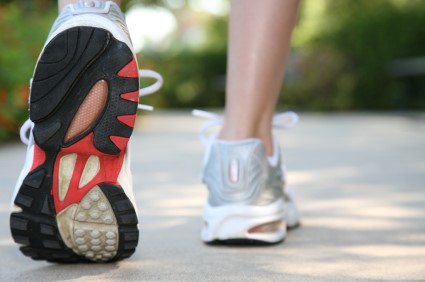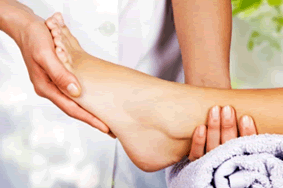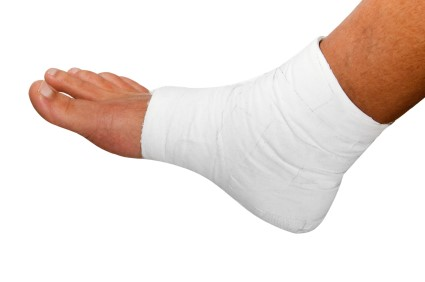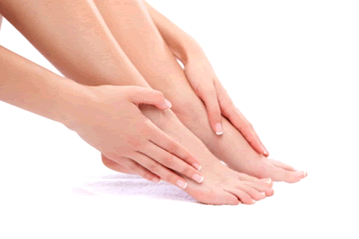Rheumatoid Arthritis in the Feet
Although rheumatoid arthritis attacks multiple bones and joints throughout the entire body, ninety percent of people who actually develop this condition usually do so in the foot or ankle area. Those who develop this kind of arthritis in the feet usually develop symptoms around the toes and forefeet first, before anywhere else. Rheumatoid arthritis appears to have a genetic component. If it runs in the family, then you will be more likely to develop it as well.
Rheumatoid arthritis is an autoimmune disorder in which the body’s own immune system attacks the lining of the membranes surrounding the joints. This causes inflammation of the membrane lining, and the gradual destruction of the joint’s cartilage and even bone.
Some of the most common symptoms that are associated with RA include pain and swelling of the feet. Stiffness in the feet is also another common symptom that people experience. Those who have RA in the feet usually feel the pain in the ball or sole of their feet. This can get to be very painful at times. A person's joints can even shift and become deformed after a period of time.
In order to properly diagnose RA in the feet it is usually necessary for a doctor or podiatrist to evaluate the area. Your doctor will also question you about your medical history, occupation, etc., to determine whether anything in your lifestyle may have triggered the condition. There are a number of tests that may be performed to help diagnose RA, such as a rheumatoid factor test. There is, however, no one single test that will tell you for sure if you have RA. There are different X-rays that can be taken as well to determine if a person has RA in their feet.
There is a range of treatment options for rheumatoid arthritis. Treatment of RA is usually a lifelong process that includes a variety of methods of treatment and therapy. Your doctor can prescribe special shoes that should help with arch support as well as heel support. A physical therapist can help those with this condition learn exercises which will keep their joints flexible. Surgery may be needed to correct some of the issues with the feet, such as bunions, and hammertoes. Fusion is usually the most successful surgical option for rheumatoid arthritis. However, people need to keep in mind that there are some risks associated with these surgeries.
Rheumatoid Arthritis can affect People of All Ages
 Rheumatoid arthritis (RA) exists as an autoimmune disease that attacks healthy tissue cells in the body, leading to pain and inflammation. Rheumatoid arthritis can happen at any age, with children being able to develop juvenile rheumatoid arthritis. It is especially important to regularly visit your doctor for treatment in preventing the progression of RA symptoms. Treatment options include different anti-inflammation medications and physical therapy. If RA is not treated properly, it can lead to eventual disability.
Rheumatoid arthritis (RA) exists as an autoimmune disease that attacks healthy tissue cells in the body, leading to pain and inflammation. Rheumatoid arthritis can happen at any age, with children being able to develop juvenile rheumatoid arthritis. It is especially important to regularly visit your doctor for treatment in preventing the progression of RA symptoms. Treatment options include different anti-inflammation medications and physical therapy. If RA is not treated properly, it can lead to eventual disability.
Because RA affects more than just your joints, including the joints in your feet and ankles, it is important to seek early diagnosis from your podiatrist if you feel like the pain in your feet might be caused by RA. For more information, contact Dr. Steven Shlonsky of Kentucky. Dr. Shlonsky will treat your foot and ankle needs.
What Is Rheumatoid Arthritis?
Rheumatoid Arthritis (RA) is an autoimmune disorder in which the body’s own immune system attacks the membranes surrounding the joints. Inflammation of the lining and eventually the destruction of the joint’s cartilage and bone occur, causing severe pain and immobility.
Rheumatoid Arthritis of the Feet
Although RA usually attacks multiple bones and joints throughout the entire body, almost 90 percent of cases result in pain in the foot or ankle area.
Symptoms
- Swelling & pain in the feet
- Stiffness in the feet
- Pain on the ball or sole of feet
- Joint shift and deformation
Diagnosis
Quick diagnosis of RA in the feet is important so that the podiatrist can treat the area effectively. Your doctor will ask you about your medical history, occupation, and lifestyle to determine the origin of the condition. Rheumatoid Factor tests help to determine if someone is affected by the disease.
If you have any questions please feel free to contact our office located in Louisville, KY. We offer the newest diagnostic and treatment technologies for all your foot and ankle needs.
Cierra Portman had Surgery to Repair Foot Injury
 Cierra Portman, freshman forward for Missouri women’s basketball team, had to have surgery in late April to repair a Lisfranc injury. A screw was inserted during surgery to repair her foot injury. Porter sustained the injury while playing during high school, which she continued to play through into her first year at MU. Following the surgery, Porter was put on recovery for 6 to 8 weeks, with her father and assistant coach, Michael Porter Sr., hopeful that she will be pain-free again.
Cierra Portman, freshman forward for Missouri women’s basketball team, had to have surgery in late April to repair a Lisfranc injury. A screw was inserted during surgery to repair her foot injury. Porter sustained the injury while playing during high school, which she continued to play through into her first year at MU. Following the surgery, Porter was put on recovery for 6 to 8 weeks, with her father and assistant coach, Michael Porter Sr., hopeful that she will be pain-free again.
Foot surgery is sometimes necessary to fix a foot ailment. To learn more, consult with Dr. Steven Shlonsky of Kentucky. Dr. Shlonskywill assist you with all of your foot and ankle needs.
When Is Surgery Necessary?
Foot and ankle surgery is generally reserved for cases in which less invasive, conservative procedures have failed to help with the problem. Some of the cases in which surgery may be necessary are:
- Removing foot deformities like bone spurs and bunions
- Severe arthritis that has caused bone issues
- Cosmetic reconstruction
What Types of Surgery Are There?
The type of surgery you receive will depend on the nature of the problem you have. Some of the possible surgeries include:
- Bunionectomy for painful bunions
- Surgical fusion for realignment of bones
- Neuropathy decompression surgery to treat nerve damage
Benefits of Surgery
Although surgery is usually a last resort, it can provide more complete pain relief compared to non-surgical methods and may allow you to finally resume full activity.
Surgical techniques have also become increasingly sophisticated. Techniques like endoscopic surgery allow for smaller incisions and faster recovery times.
If you have any questions please feel free to contact our office located in Louisville, KY. We offer the newest diagnostic and treatment technologies for all your foot and ankle needs.
Tips for Running Safely and Preventing Injuries
 According to greatist.com, there are some tips to follow for those who are avid runners, especially for avoiding injuries. If you plan on preparing for a marathon, gradually break into a running routine and make sure to incorporate training into your schedule. Stretching is also important for ensuring that your muscles don’t become too strained or overstressed. Don’t forget to take breaks and rest in between your training. Make sure to invest in more than just one sturdy pair of running shoes, see a doctor if you’re experiencing any pain in your feet, stay hydrated, and be aware of your pronation style to avoid injury.
According to greatist.com, there are some tips to follow for those who are avid runners, especially for avoiding injuries. If you plan on preparing for a marathon, gradually break into a running routine and make sure to incorporate training into your schedule. Stretching is also important for ensuring that your muscles don’t become too strained or overstressed. Don’t forget to take breaks and rest in between your training. Make sure to invest in more than just one sturdy pair of running shoes, see a doctor if you’re experiencing any pain in your feet, stay hydrated, and be aware of your pronation style to avoid injury.
Runners can still be prone to running injuries even with proper precautions. For more information about treatment, consult with Dr. Stephen Shlonsky of Kentucky. Dr. Shlonskywill assist you with all of your foot and ankle needs.
How to Prevent Running Injuries
Many common running injuries are caused by overuse and overtraining. When the back of the kneecap starts wearing out and starts causing pain in your knee, this is commonly referred to as runner’s knee. Runner’s knee is a decrease in strength in your quadriceps and can occur if you’re not wearing properly fitted or supporting shoes. To prevent runner’s knee, focusing on hip strengthening is a good idea, as well as strengthening your quads to keep the kneecaps aligned.
What Are Some Causes of Running Injuries?
- One cause of a common running injury is called iliotibial band syndrome.
- Plantar fasciitis is also another common injury.
- Stress fractures can occur from overtraining, lack of calcium, or even your running style.
Best Ways to Prevent Running Injuries
- Wear footwear that fits properly and suits your running needs.
- Running shoes are the only protective gear that runners have to safeguard them from injury.
- Make a training schedule. Adding strengthening exercises as well as regular stretching can help keep you strong and limber and can lessen the possibility of injuries.
- Stretching keeps muscles limber, this will help you gain better flexibility.
If you have any questions please feel free to contact our office located in Louisville, KY. We offer the newest diagnostic and treatment technologies for all your foot and ankle needs.
Certain Factors such as Diet can lead to Increased Sweating
 Although sweating is a natural process, the body’s way of regulating our overall temperature, certain factors may lead to increased sweating. Our bodies have between two to four million sweat glands, and factors such as obesity, being sedentary, caffeine, smoking, and synthetic fabrics can make us prone to sweating. Excessive sweating is also known as a common condition in which glands across our body produce more sweat than usual. See a doctor if you feel that your sweating is flaring up excessively.
Although sweating is a natural process, the body’s way of regulating our overall temperature, certain factors may lead to increased sweating. Our bodies have between two to four million sweat glands, and factors such as obesity, being sedentary, caffeine, smoking, and synthetic fabrics can make us prone to sweating. Excessive sweating is also known as a common condition in which glands across our body produce more sweat than usual. See a doctor if you feel that your sweating is flaring up excessively.
If you are suffering from hyperhidrosis contact Dr. Stephen Shlonsky of Kentucky. Dr. Shlonskycan provide the care you need to keep your pain free and on your feet.
Hyperhidrosis of the Feet
Hyperhidrosis is a rare disorder that can cause people to have excessive sweating of their feet. This can usually occur all on its own without rigorous activity involved. People who suffer from hyperhidrosis may also experience sweaty palms.
Although it is said that sweating is a healthy process meant to cool down the body temperature and to maintain a proper internal temperature, hyperhidrosis may prove to be a huge hindrance on a person’s everyday life.
Plantar hyperhidrosis is considered to be the main form of hyperhidrosis. Secondary hyperhidrosis can refer to sweating that occurs in areas other than the feet or hands and armpits. Often this may be a sign of it being related to another medical condition such as menopause, hyperthyroidism and even Parkinson’s disease.
In order to alleviate this condition, it is important to see your doctor so that they may prescribe the necessary medications so that you can begin to live a normal life again. If this is left untreated, it is said that it will persist throughout an individual’s life.
A last resort approach would be surgery, but it is best to speak with your doctor to find out what may be the best treatment for you.
If you have any questions please feel free to contact our office located in Louisville, KY. We offer the newest diagnostic and treatment technologies for all your foot and ankle needs.
Managing Your Morton’s Neuroma
 Morton’s neuroma is characterized as the thickening of the tissue surrounding the nerves of the toes. Also known as interdigital neuroma, the condition occurs when the nerves of the toes become irritated and inflamed, which can lead to tingling or numbing sensations. Changing any ill-fitting footwear is important for preventing further progression of Morton’s neuroma. Avoid shoes such as high heels and opt for shoe inserts or custom orthotics to reduce pressure on your toes.
Morton’s neuroma is characterized as the thickening of the tissue surrounding the nerves of the toes. Also known as interdigital neuroma, the condition occurs when the nerves of the toes become irritated and inflamed, which can lead to tingling or numbing sensations. Changing any ill-fitting footwear is important for preventing further progression of Morton’s neuroma. Avoid shoes such as high heels and opt for shoe inserts or custom orthotics to reduce pressure on your toes.
Morton’s Neuroma is a very uncomfortable condition to live with. If you think you have Morton’s neuroma contact Dr. Stephen Shlonsky of Kentucky. Dr. Shlonskycan provide the care you need to keep your pain free and on your feet.
Morton’s Neuroma
Morton's neuroma is a painful foot condition that commonly affects the areas between the second and third or third and fourth toe, although other areas of the foot are also susceptible. Morton’s neuroma is caused by an inflamed nerve in the foot that is being squeezed and aggravated by surrounding bones.
What Increases the Chances of having Morton’s Neuroma?
- -Ill-fitting high heels or shoes that add pressure to the toe or foot
- -Jogging, running or any sport that involves constant impact to the foot
- -Flat feet, bunions, and any other foot deformities
Morton’s neuroma is a very treatable condition. Orthotics and shoe inserts can often be used to alleviate the pain on the forefront of the feet. In more severe cases, corticosteroids can also be prescribed. In order to figure out the best treatment for your neuroma, it’s recommended to seek the care of a podiatrist who can diagnose your condition and provide different treatment options.
If you have any questions please feel free to contact our office located in Louisville, KY. We offer the newest diagnostic and treatment technologies for all your foot and ankle needs.
Read more about Morton’s neuroma.
Eat Healthy and Take Rests from Activity to Prevent Stress Fractures
 Stress fractures are injuries commonly caused by strenuous exercise, so it’s important to take breaks during your exercise routines. It is recommended to slowly increase your strength and endurance over time to prevent stress fractures. Stress fractures are caused by the constant pounding that your bones take over a period of time, as muscles become exhausted from strenuous exercise and are unable to protect the bones. Eating a healthy diet can help prevent stress fractures. Calcium and vitamin D are both important in building and strengthening bones.
Stress fractures are injuries commonly caused by strenuous exercise, so it’s important to take breaks during your exercise routines. It is recommended to slowly increase your strength and endurance over time to prevent stress fractures. Stress fractures are caused by the constant pounding that your bones take over a period of time, as muscles become exhausted from strenuous exercise and are unable to protect the bones. Eating a healthy diet can help prevent stress fractures. Calcium and vitamin D are both important in building and strengthening bones.
Activities where too much pressure is put on the feet can cause stress fractures. To learn more, contact Dr. Stephen Shlonsky of Kentucky. Dr. Shlonsky can provide the care you need to keep your pain free and on your feet.
Dealing with Stress Fractures of the Foot and Ankle
The Stress Fractures occur on the foot and ankle when muscles in these areas weaken from too much or too little use. Then the feet and ankles lose support when walking or running from the impact of the ground. Since there is no protection the bones receive the full impact of each step. The stress on the feet causes cracks to form in the bones, thus called stress fractures.
What are Stress Fractures?
Stress fractures occur frequently in individuals whose daily activities cause great impact on the feet and ankles. Stress factors are most common among:
-runners
-people affected with Osteoporosis
-play tennis or basketball
-gymnastics
-high impact workouts
Symptoms
Pain from the fractures occur in the area of the fractures, and can be constant or intermittent. It will often cause sharp or dull pain with swelling and tenderness. Engaging in any kind of activity which involves in high impact will aggravate pain.
If you have any questions please feel free to contact our office located in Louisville, KY. We offer the newest diagnostic and treatment technologies for all your foot and ankle needs.
Dealing with Stress Fractures of the Foot and Ankle
Stress fractures are small breaks in the bone that are caused by repetitive stress. They typically occur due to overuse, forcing the bones of the foot or ankle to continually absorb the full impact of each step someone takes. Stress fractures can also be caused by abnormal foot structure, osteoporosis, bone deformities, or wearing improper footwear during exercise.
Stress fractures are common for individuals whose daily activities cause high levels of impact on their feet and ankles. Individuals who run, play tennis or basketball, or practice gymnastics tend to experience these fractures more frequently. Anyone is susceptible to this problem, though. Individuals who are normally sedentary and suddenly begin an intense, high impact workout may sustain stress fractures. This is because their muscles are not yet strong enough to handle and cushion the intensity of their activity. Osteoporosis may also cause someone to get stress fractures, because the disease weakens an afflicted person's bones and makes it easier for them to break down.
Pain from stress fractures typically occurs in the general area of the fracture. Pain can also manifest as “pinpoint pain” or pain that is felt when the site of the injury is touched, and can be accompanied by swelling. It may occur during or after activity, and it may disappear while resting and return when standing or moving. Engaging in any kind of activity, high impact or otherwise, will aggravate the pain. If the intensity of the activity increases before the stress fracture has properly healed, it can cause a full fracture.
Treatment can vary depending on the individual and the degree of injury. The primary way to treat a stress fracture is to rest the hurt foot. Some fractures will heal quickly with only a little bit of rest, while others may require a long rest period and the use of crutches, immobilization, or physical therapy. Under certain circumstances, surgery may be required to install support pins around the fracture to assist in healing.
If you are undergoing a new exercise regimen in running or some other kind of high impact activity, set incremental goals on a weekly basis so you can build up muscle strength. Make sure to wear supportive shoes to better protect you feet.
If you begin to experience any symptoms of stress fractures, you should stop exercising and rest. If the symptoms persist, consult with your podiatrist. Remembering these tips can help you prevent stress fractures to your foot and ankle, and allow you to continue living normally.
Treating Your Diabetic Feet
 Being a diabetic patient means the risk of neuropathy and the loss of sensation in areas of your body such as the feet. When your feet loses feeling, that means they become at risk for complications like amputation. Neuropathy is caused by severe nerve damage to the feet, which can also “cause changes to the foot structure as the nerves affect muscle function, leading to foot deformities.” Wounds or injuries in the feet may go unnoticed and can become infected. Diabetic patients also have reduced blood circulation, making open wounds more prone to infection.
Being a diabetic patient means the risk of neuropathy and the loss of sensation in areas of your body such as the feet. When your feet loses feeling, that means they become at risk for complications like amputation. Neuropathy is caused by severe nerve damage to the feet, which can also “cause changes to the foot structure as the nerves affect muscle function, leading to foot deformities.” Wounds or injuries in the feet may go unnoticed and can become infected. Diabetic patients also have reduced blood circulation, making open wounds more prone to infection.
Diabetic foot care is important in preventing foot ailments such as ulcers. If you are suffering from diabetes or have any other concerns about your feet contact Dr. Stephen Shlonsky of Kentucky. Dr. Shlonskycan provide the care you need to keep your pain free and on your feet.
Diabetic Foot Care
Diabetes affects millions of people every year. Diabetes can damage blood vessels in many parts of the body, including the feet. Because of this, taking care of your feet is essential if you have diabetes, and having a podiatrist help monitor your foot health is highly recommended.
The Importance of Caring for Your Feet
- Routinely inspect your feet for bruises or sores.
- Wear socks that fit your feet comfortably.
- Wear comfortable shoes that provide adequate support.
Patients with diabetes should have their doctor monitor their blood levels because blood sugar levels play such a huge role in diabetic care. Monitoring these levels on a regular basis is highly advised.
It is always best to inform your healthcare professional of any concerns you may have regarding your feet, especially for diabetic patients. Early treatment and routine foot examinations are keys to maintaining proper health, especially because severe complications can arise if proper treatment is not applied.
If you have any questions please feel free to contact our office located in Louisville, KY. We offer the newest diagnostic and treatment technologies for all your foot and ankle needs.
Elderly and their Feet
While proper foot care is important for everybody, senior citizens have the tendency to be more susceptible to certain conditions. The elderly should therefore be well informed about any problems that may arise and about what they can do to properly avoid or treat them.
Some of the most common foot problems seniors are susceptible to include foot ulcers, ingrown toenails, fallen arches, and fungal nails. A foot ulcer is an open sore on the foot and can be a result of diabetes and decreased sensation in the feet. An ingrown toenail is defined as when the nail grows into the side of the toe. Fallen arches are indicated by the instep of the foot collapsing. A fungal nails is a condition that results in deformed and discolored toenails.
In order to avoid these conditions it is recommended that the feet be inspected by the patient on a regular basis. If these inspections are carried out routinely, there is a good likelihood that problems can be identified before they become severe, or can even be avoided altogether. If any abnormality is discovered, it is important that the individual consult a podiatrist for diagnosis and information on treatment options.
Proper foot hygiene is also important. Making sure that you always have clean, dry socks on can be a major deterrent to many different problems including bacterial infections, foot odor, and certain types of fungus. Wet feet are a major cause of many of these problems. If your socks get wet, it is important to change them. Walking around in wet socks may not only lead to various infections, but can irritate the skin and result in a number of various complications. Clean, dry feet are less likely to be affected by fungal and other infections.
As people age, the fat present on your feet begins to deteriorate. The protective nature of this fat keeps the feet healthy by providing a barrier between your bones and the ground. This also aids in giving the skin on the feet a certain amount of elasticity. This is one factor that causes elderly people to develop some serious foot issues. Foot moisturizers can be helpful to avoid certain problems associated with this. However, water-based moisturizers do not work as well for elderly people as they do for the young. Instead, it is more effective to use an emollient instead. An emollient is effective because it binds the water in the foot, keeping it from becoming absorbed too readily which will result in dry skin. Emollients also have a special property called occlusion, which provides a layer of oil on the skin. This layer prevents the foot from drying up and can be very effective in treating dry skin disorders. If you can keep the skin on your feet healthy, this will substantially reduce the number of foot problems you will encounter in old age.
Proper footwear is another way to keep feet healthy. Shoes that fit well and provide proper support help prevent ingrown toenails and fallen arches.
Certain medical conditions such as diabetes or poor blood circulation increase the risk for foot issues. For individuals with any of these conditions it is extremely important to conduct regular foot inspections to make sure that there are no sores or infections present.







